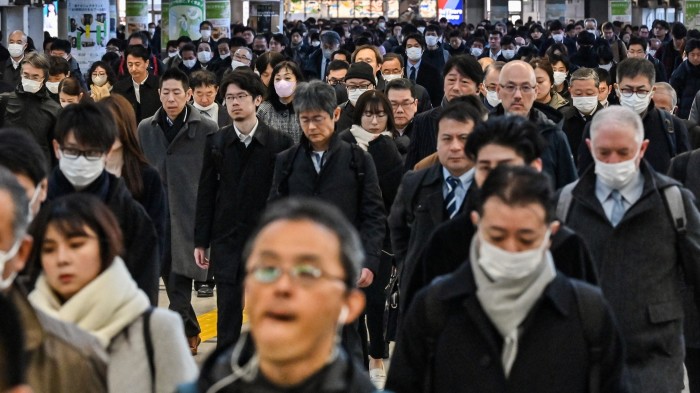In the first week of November, launching a month of campaigns around the risks of karoshi, or death by overwork, Japan’s Ministry of Health, Labour and Welfare (MHLW) opened a confidential hotline that encouraged the nation’s workers to complain about their bosses.
The hotline operators were braced, as they have been every November for the past few years, for a wide range of accounts of workplace miseries — from unpaid wages and harassment to poor conditions and failure to protect mental health.
But the central aim, as always, was to survey the problem of excessive working hours — an issue that has, for decades, lived at the heart of Japan’s worker-employer relationship and entrenched the idea that Japanese workplaces thrive on unpaid overtime, presenteeism, and coercion.
The situation is changing, with average working hours now looking like they are coming down. However, academics say that hidden factors complicate the picture. Excessive overtime can be masked by the country’s army of part-time employees. Other strategies, such as giving staff “name only” management roles that allow them to work hours far beyond official time-stamped limits, also obscure reality.
But the bigger question, which the same academics say becomes more pressing with each passing year, is whether that other great challenge confronted by Japan — the rapid ageing and shrinking of its population — is making the overwork problem better, or worse. For example, is it is forcing through long-overdue productivity boosters, such as digitisation and automation, quickly enough to make any difference?
In many sectors of the economy, labour is in increasingly tight supply — partly because of demographics, but also because of low labour market liquidity, and limited movement of the workforce between areas of low and high demand.
In some areas, such as pay, these labour shortages are strengthening workers’ hands. Keisuke Nakamura, a researcher on labour issues, says workers’ scarcity value, and the ever more pressing need for companies to attract and retain them, means bosses will come under increasing pressure to compromise on working hours. However, he also warns that labour shortages can pile pressure on workers to “fill in” the gaps which, in many cases, can mean working longer hours of undeclared overtime.
It is now 10 years since Japan brought into force a law to prevent death and injury from overwork. The legislation was pushed through parliament in recognition of the fact that the situation had deteriorated and had, it noted, “grown into a significant societal concern in Japan”.
In terms of some of the most recent headline figures, broader progress looks mixed. According to the MHLW’s 2024 nationwide survey of more than 26,000 businesses, employees reported that they had worked illegal overtime at 44.5 per cent of those organisations — a 1.9 percentage point increase from the previous year’s survey.
At the same time, though, the overall trend of average working hours shows a steady decline for both men and women. In a government report tracking working patterns since 1973, the average hours worked per week fell from 50 hours for men to below 45 and from about 45 for women to below 35 — close to the average for all non-farm employees in the US.
The annual karoshi prevention campaign, and the obligation on the government to conduct the accompanying surveys, are explicitly built into the 2014 act. More powerful than that law, however, were the 2018 Work Style reforms — a series of measures phased in over several years, which, among other changes, capped the overtime that companies can require staff to work at 100 hours in any given month. Critically, the rules were extended to the vast realm of small and medium-sized businesses, which employ roughly 70 per cent of the Japanese workforce.
The impact of the reforms, along with their implications for the wider Japanese economy, has been most visible in the transportation sector, where strict limits on the number of hours of overtime that truck drivers could work came into effect in April.
Dubbed the “2024 problem”, the change has prompted grave warnings of what shorter hours will mean to a consumer society that has come to depend on 24-hour convenience stores, just-in-time delivery, and a logistics system built when labour was plentiful and massive overtime was the norm.
In a study published in July, the Nomura Research Institute projected that Japan would have 36 per cent fewer truck drivers than needed by 2030 because of the curbs on hours. In part, this reflects the demographics of an industry where 20 per cent of drivers are currently over 60 years old and only 10 per cent are under 30.
The many ideas discussed around how to offset the 2024 problem — reserved lanes for self-driving trucks, incentives to customers for less prompt delivery, and switching some logistics functions from the roads to the bullet train network — are instructive.
Labour shortages appear to be inspiring productivity innovations that seemed less urgent in an era when labour was in ready supply.
Corporate Japan, says a recent report by the Daiwa Institute of Research, is increasingly thinking along the same lines in terms of the productivity gains it must rush through in order to keep businesses going. Companies have been forced to streamline working processes and to reduce the number of low-priority tasks, the think-tank says.
Still, until such measures take full effect, it warns, large companies are tending to compensate for the tighter caps on working hours by hiring more aggressively.
Japan may be on the road to solving its long hours problems, but is still moving slowly. A positive milestone would be deciding it no longer needed the karoshi hotline.
Read the full article here

